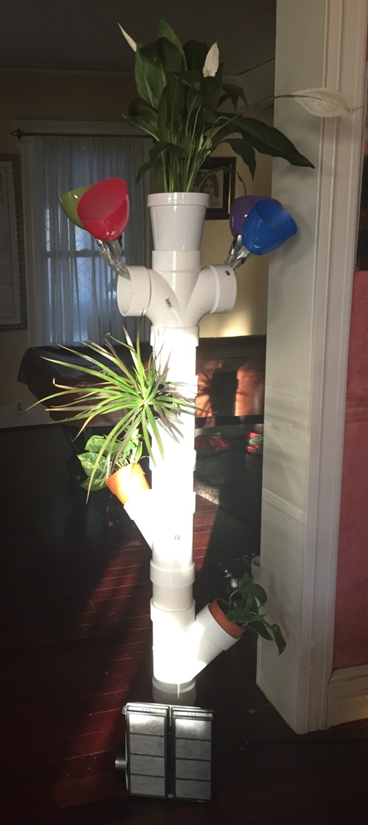Managing the air that we breathe inside our homes should not be subject to expensive and costly modifications. While some situations will always require professional expertise and expensive equipment, it is possible to empower the occupants to improve their indoor air by DIY solutions. The Do iT Yourself IAQ Improvement initiative promotes pragmatic actions supported by modern research to foster individual health.
The main recommended strategies to reduce exposure to the major sources of indoor-generated PM2.5 are:
- Stop smoking indoors
- Use a stove top exhaust fan while cooking
- Ensure that there is adequate ventilation, especially when doing activities that may generate PM2.5
- Use AirNow to help monitor and protect yourself and your family from elevated PM levels before opening windows and doors
- Filter out all that visible and invisible particulate matter.
While a number of solutions are available, for some a DIY solution might be the best option. Jeffrey E. Terrell, M.D., director of the University of Michigan Health System’s Michigan Sinus Center offers a do-it-yourself solution at a fraction of the cost. Jeffrey E. Terrell, M.D., director of the University of Michigan Health System’s youtube video
There are a large number of air filtration choices can do a reasonable job of filtering out the particulate matter and allergens. EPA provides a useful guide that can be used as a ready reference. EPA guide to Air Cleaners
You can also look at this link before buying air purifiers: California Government Research on Certified Air Cleaners
You can look at this link before buying air filters: California Government Research
References- [1] K. Yang et al. “Urban air pollution study based on GIS”. In: 2009 Joint Urban Remote Sensing Event. May 2009
- [2] Pope III C et al. “Lung cancer, cardiopulmonary mortality, and long-term exposure to fine particulate air pollution”
- [3] Guerreiro, Cristina. "Air quality in Europe: 2013 report." (2013)
- [4]Canada Health Guidance on PM2.5
Coarse particles (PM10-2.5) are of less concern, although they can irritate a person's eyes, nose, and throat. (EPA)
SECTORS MORE VULNERABLE TO PARTICULATE MATTER ARE :
- People with heart and lung diseases such as coronary artery disease, congestive heart failure, and asthma or chronic obstructive pulmonary disease (COPD), are more vulnerable because PM can aggravate these diseases. (EPA)
- Senior Citizens: Many studies show that when particle levels are high, older adults are more likely to be hospitalized, and some may even die of aggravated heart or lung disease (EPA)
- Infants and Young Children: Their lungs are still developing; children spend more time at higher activity levels; and both these factors make them more vulnerable to PM (EPA)
- Pregnant Woman: scientists are evaluating new studies that suggest that exposure to high particle levels may also be associated with low birth weight in infants, pre-term deliveries, and possibly fetal and infant deaths (EPA)
-
Protecting yourself from VOCs (American Lung Association):
- Avoid or limit the use of products with high VOCs
- Use products that are low in VOCs, including some sources like paints and building supplies. Look for "Low VOCs" information on the label.
- Buy only as much as you need for the project. Dispose off any leftover or unused products safely.
- Always follow manufacturers' directions when using these products.
- Add ventilation when you use products with VOCs indoors
- Open windows and add a fan to pull the indoor air outside while you're using products with high VOCs.
- Increasing the amount of fresh air in your home will help reduce the concentration of VOCs indoors.
- Let new carpet or new building products air outside to release VOCs before installing them.
- Don't store products with VOCs indoors, including in garages connected to the building.
- Make sure your office or school ventilation systems are working effectively to reduce VOCs produced by printers or copiers
- Don't smoke and keep all buildings smokefree. Tobacco smoke contains VOCs among other carcinogens.
DIY Strategy to reduce VOC exposure
It is well understood that air filtration systems and air purifiers do not reduce the level of all the indoor air pollutants, and some types of air filtration systems can actually aggravate the problem. VOC’s are generally are not removed by air filters, and need a second line of defense NASA research has shown that low-light-requiring houseplants, along with activated carbon plant filters, have demonstrated the potential for improving indoor air quality by removing trace organic pollutants from the air
NASA research identified plants that are effective in providing a natural way of combating “sick building syndrome.” In order to implement NASA research recommendations, you can create a vertical garden that doubles up as a lamp. This saves space and provides additional utility value. NASA research recommends many different plants. Out of these, plants like Peace Lily, Golden Pothos and Dracaena are sturdy, and need low to medium light and quite suitable for vertical garden.
NASA research recommends many different plants. Out of these, plants like Peace Lily, Golden Pothos and Dracaena are sturdy, and need low to medium light and quite suitable for vertical garden.
There are a few simple ways to protect yourself from formaldehyde indoors. (American Lung Association)
- Choose low-formaldehyde products when building or remodeling.
- Furniture and pressed-wood board made with laminated surfaces release less formaldehyde and other VOCs.
- If possible, use non-toxic alternatives to formaldehyde-containing products like glue and adhesives.
- Ventilate indoor spaces. Open windows or use exhaust fans to blow indoor air out and bring fresh air in.
- Make sure any combustion appliance has a separate exhaust to the outdoors.
- Remember to ventilate indoor spaces when using cleaners, cosmetic products like nail polish remover or most paints.
- Air out new furniture and pressed-wood products.
- Many consumer products that emit formaldehyde, such as plywood and particle board, release the highest concentrations when they are new. Air them out before installing them or bringing them indoors.
- Don't allow smoking indoors. Not smoking and prohibiting smoking indoors can reduce exposure to formaldehyde. Secondhand smoke contains many chemicals in addition to formaldehyde that can harm health.
- Wash permanent press clothing before wearing. Formaldehyde is used in the production of special fabrics.
References
- Agency for Toxic Substances and Disease Registry (ATSDR). Tox FAQs for Formaldehyde. Atlanta, GA: U.S. Department of Health and Human Services, Public Health Service. 2011. Accessed August 26, 2015.
- California Air Resources Board (CARB). Report to the California Legislature: Indoor Air Pollution in California. Sacramento, CA: California Environmental Protection Agency. 2005.
- Agency for Toxic Substances and Disease Registry (ATSDR). Revised Health Consultation –Formaldehyde Sampling at FEMA Temporary Housing Units - Baton Rouge, Louisiana. Atlanta, GA: U.S. Department of Health and Human Services, Public Health Service. 2007.
- Institute of Medicine, Division of Health Promotion, Indoor Air and Disease Prevention. Clearing the Air: Asthma and Indoor Air Exposures. Washington, DC: National Academies Press. 2000; Kanchongkittiphon W, et al. Indoor Environmental Exposures of Asthma: An Update to the 2000 Review by the Institute of Medicine. Environmental Health Perspectives. 2015; 123: 6-20.
Indoor Fountain for Reducing and Removing Carbon Dioxide Water fountain Let’s start with a choice - what scares you less? High School chemistry or gardening? For those with a green thumb or with fond memories of chemistry lessons, there is a chance that you are familiar with lime. Slaked lime is easy available in garden centers and this cheap and non-toxic material soaks up more carbon dioxide than other solvents per unit of weight. We show here a simple water fountain (decorated aesthetically!!) where we have added a spoon of slaked lime to water. This lovely decoration piece serves as a humidifier and captures CO2.

Expert Point:Carbon Dioxide Capture Using Calcium Hydroxide Aqueous Solution as the Absorbent
lime water sequesters CO2 to generate calcium carbonate (CaCO3) in a one-step process, producing a safe product that has many useful applications
How can you protect yourself from carbon monoxide?
- Many people are poisoned by CO after bad weather emergencies, like snowstorms and hurricanes.
- Make sure appliances are installed and working according to manufacturers' instructions and local building codes.
- make sure all appliances are fully vented to the outdoors.
- Have the heating system, chimney and flue inspected and cleaned by a qualified technician every year.
- Make sure your furnace has an adequate intake of outside air.
- Use appliances and stoves appropriately.
- Do not use ovens and gas ranges to heat your home.
- Do not burn charcoal, kerosene lanterns or portable camp stoves inside a home, cabin, recreational vehicle or camper.
- Do not operate gasoline-powered engines in confined areas such as garages or basements.
- Never leave your car or mower running in a closed garage.
- If you must use a portable generator in an emergency, keep it as far away from your home as possible and away from windows or doors.
- Do not smoke inside your home. Cigarettes, pipes and cigars also produce carbon monoxide.
- Install a CO detector with an audible alarm near sleeping areas, on indoor walls shared with a garage, and near combustion equipment in your home.
- Raub JA, Matheieu-Nolf M, Hampson NB, Thom SR. Carbon Monoxide Poisoning—A Public Health Perspective. 2000. Toxicology 145: 1-14.
- Weaver LK. Carbon Monoxide Poisoning. 2009. New England Journal of Medicine 360: 1217-1225.
- Centers for Disease Control and Prevention. QuickStats: Average Annual Number of Deaths and Death Rates from Unintentional, Non–Fire-Related Carbon Monoxide Poisoning,*† by Sex and Age Group — United States, 1999–2010. Morbidity and Mortality Weekly Report (January 24, 2014) 63(03):65.
- U.S. EPA. 2010 Final Assessment: Integrated Science Assessment for Carbon Monoxide. U.S. Environmental Protection Agency, Washington, DC, EPA/600/R-09/019F, 2010.
- American Lung Association
- Reduce moisture that builds from everyday activity.
- Install and use exhaust fans that are vented to the outdoors in kitchens and bathrooms and vent clothes dryers outdoors.
- Ventilate the attic and crawl spaces to prevent moisture build-up.
- Keep the house clean.
- House dust mites, pollens, animal dander, and other allergy-causing agents can be reduced, although not eliminated, through regular cleaning.
- People who are allergic to these pollutants should use allergen-proof mattress encasements
References
At present, EPA does not recommend using air cleaners to reduce levels of radon and its decay products. The effectiveness of these devices is uncertain because they only partially remove the radon decay products and do not diminish the amount of radon entering the home. EPA plans to do additional research on whether air cleaners are, or could become, a reliable means of reducing the health risk from radon. EPA's booklet, Residential Air-Cleaning Devices, provides further information on air-cleaning devices to reduce indoor air pollutants.
HUD VideoWhat can we do to reduce the risk of mold formation?
EPA Mold Guide
To learn more about biological pollutants, read Biological Pollutants in Your Home issued by the U.S. Consumer Product Safety Commission and the American Lung Association. For contact information, see the section, "Where to Go For Additional Information."

